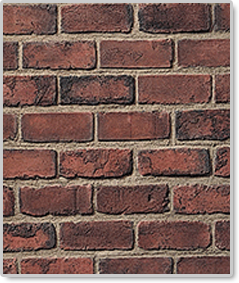Taking Care of Your Brick Siding

Routine Cleaning
For general cleaning of your brick siding, you should use a mild detergent, a hose, and a brush. Using a power washer will risk damaging your mortar and caulking, and if your brick is painted, power washing painted brick will likely cause the paint to peel or fade.
If lawn or garden sprinklers have left hard-water spots on your home’s brick exterior, these can be removed with an acid-based brick cleaner. If you decide to do-it-yourself, you will want to be very careful, follow all label directions, wear rubber gloves and eye protection, cover nearby plantings, and apply with a stiff-bristled nylon brush on an extension handle. And then be sure to rinse thoroughly when finished (see types, costs, and reviews of: brick cleaners; rubber gloves; eye protection).
If you have stains from vegetation that is growing near or on your brick siding, these can be removed with oxygen bleach or fungicide solutions (see types, costs, and reviews of oxygen bleaches). For best results, you should first clean the areas with a stiff-bristled broom to remove any loose material. And then apply the cleaning solution in dry weather so that the application has time to work before being diluted by the next rainfall.
If your bricks appear to have a white crystal-looking powder on them, you likely have "efflorescence" which is caused by moisture getting into your bricks and then the dissolved salts evaporating on the surface. Efflorescence can be removed with a stiff bristled broom (but don't use a wire brush, as it could dislodge the mortar between the bricks). However, if you don't remedy the source of the moisture (e.g., sealing the brick), the efflorescence will continue to come back (helpful accessory: brick sealants).
Mildew on your bricks is caused by the presence of moisture on the surface. A good cleaner for mold and mildew is a 50/50 mix of oxygen bleach and water. Be sure to use protection for your eyes, hands & skin, cover nearby plantings, and apply with a stiff-bristled nylon brush on an extension handle (helpful accessory: brick brushes). And be sure to rinse thoroughly when done.
Rust stains on brick can be caused by ironwork adjacent to your siding, or by particles of ironstone in the mortar leeching out. Rust stains on the brick can usually be cleaned by hard scrubbing with a damp stiff-bristled brush. But to keep the problem from coming back, if the source of the rust is ironwork, then it will need to be cleaned primed and re-sealed. And if it is due to ironstone in the mortar, then the affected mortar areas will need to be repaired in a process called "re-pointing."
Algae typically grows on brick siding in areas that receive little sunlight and hold moisture for long periods of time. Cleaning can be done with a mixture of 1 gallon of water and 1 cup of oxygen bleach. Be sure to use protection for your eyes, hands & skin, and cover nearby plantings, and apply with a stiff-bristled nylon brush on an extension handle. And be sure to rinse thoroughly when done.
Protecting
Applying a silane-based or siloxane-based sealer to your brick will help prevent moisture-related problems such as efflorescence and spalling. Your brick should be thoroughly cleaned before applying a sealer. However, before sealing your brick, you should check with a professional mason to confirm that sealing is appropriate for your particular brick and situation.
If you have brick sills, ensure that they properly sealed and there are no cracks in the mortar that could allow moisture to seep behind the brick below the sill.
The key to caring for your brick siding is routinely inspecting it. In particular, you will want to look for: signs of water penetrations; that all "weep" holes at the bottoms of the walls are open; that flashing is in place; no cracks forming in mortar; no bulges in the walls; no signs of spalling (face of brick flaking off); no vines creeping up; that caulking is in place and good condition; and there no signs of efflorescence, mildew, or other stains.
Vines and ivy look beautiful on brick walls, but their roots can work their way into loose mortar, and cause it to loosen it further. In addition, they can climb onto nearby woodwork, and bring insects and moisture which will cause rotting and other problems.
Repairing / Repointing
If sections of your brick wall have begun to bow outward, it is likely that moisture has gotten behind the wall and caused the mortar to deteriorate around the wall ties that hold the brick onto the side walls.
If the mortar between your bricks has begun to crack and deteriorate, then it will need to be repaired in a process called "re-pointing." Cracks are usually caused by structural movement, construction defects, temperature and moisture extremes, mortar content problems and/or erosion, and tree roots growing too close to foundations.
Spalling is when the face of the bricks begins to crack off. This is typically caused by moisture getting into the brick, freezing, and then 1/8 to 1/4 inch of the surface separates and falls off. Affected bricks will need to be replaced (or sometimes they can be turned around), and the source of the moisture needs to be remedied.
Related Articles . . .
Properly Caring For Your Wood Siding
The biggest risk to wood siding is moisture, which will lead to rotting, insect infestations, mildew, mold, paint peeling, etc. This article covers tips for protecting, cleaning, power washing, repairing, and painting your home.
Protecting and Cleaning Your Vinyl Siding
Since vinyl siding never needs painting, it might be easy to assume that this means that your vinyl siding is indestructible and requires no maintenance. But unfortunately, this is not the case.
Pest Control Advice from an Industry Insider
This article and video provides pest control advice from the owner of a pest and wildlife company, and describes keeping out pests, what to look for when hiring a professional, and what can go wrong.
Why You Need to Keep Rain Away From Your Foundation
Your home's gutters and downspouts play a very important role in protecting your home's foundation from water damage. This article explains why and how you should take care of your home's gutters and downspouts.
Is It Time to Replace My Roof?
Most asphalt roofs have a lifespan of 15-25 years, but this can vary significantly based on a variety of factors. So how can you tell if your roof needs to be replaced sooner, before damage to your home starts?









